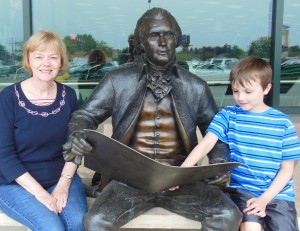Born on the 4th of July
Call me a firecracker, but Uncle Sam and I were both born on July 4. That should give me an inside track on American history, yes? But, no, last February when preparing for a President’s Day talk, I learned how much I’ve forgotten about Independence Day!
Sometimes I wonder what today’s students know about the past, but now I wonder, could I pass a test on Early American History?
Twentieth Century writer and philosopher George Santayana said, “Those who cannot remember the past are condemned to repeat it.” The bottom line is the Pilgrims came to America in 1620 both for freedom and to practice their faith freely. This is something we need to keep fresh and alive in our minds, lest we forget why and how this nation began.
In 1776, when leaders from the 13 colonies declared independence from Britain, the desire for freedom still ruled. That’s when the details of the U.S. Constitution were hammered out. The Bill of Rights was added a few years later. It’s first article states that “Congress shall make no law respecting the establishment of religion, or prohibiting the free exercise thereof, or bridging the freedom of speech, or of the press; or the right of the people to peaceably to assemble, and to petition the government for a redress of grievances.”
Here is a short test on America’s birth for you to try out:
- What was the first item of business when the first Continental Congress met on September 6, 1774?
- Answer: They opened with prayer and read several chapters from the Bible, including Psalm 35.
- Who drafted the constitution?
- Answer: Thomas Jefferson drafted the U.S. Constitution in June of 1776.
- Why did 40 leaders from the 13 colonies meet in Philadelphia on July 2, 1776?
- Answer: To approve a complete separation from Great Britain and the tyranny of government.
- After days of deliberation in a hot, stuffy room, when did they approve U.S. Constitution?
- Answer: On July 4, 1776.
- What did they do to mark the occasion?
- Answer: On July 8th, they carried the Declaration of Independence outside Independence Hall. There they read it to the assembled crowd and rang the Liberty Bell.
- What is the inscription on the Liberty Bell?
- Answer: “Proclaim liberty throughout the land, to all the inhabitants thereof.” (Leviticus 25: 10.)
- How many times during the American Revolution, did the Continental Congress issued proclamations for prayer?
- Answer: 15 times they made prayer proclamations appealing for God’s help or in thanksgiving.
- How many of the 56 signers of the Declaration of Independence were graduates of what would now be considered Bible schools or seminaries?
- Answer: Over half.
- Who said, “The general principles on which the fathers achieved independence (freedom) were the general principles of Christianity.”
- Answer: John Adams, who signed the Declaration and became the second president of the United States.
- What is inscribed on every major building in Washington, D.C.?
- Answer: Scripture.
How did you do? Give yourself one point for each correct answer. Send me a message with your score and your thoughts!
For a quick refresher on the Bill of Rights, go to:

My grandson and I visited with Thomas Jefferson this week.

